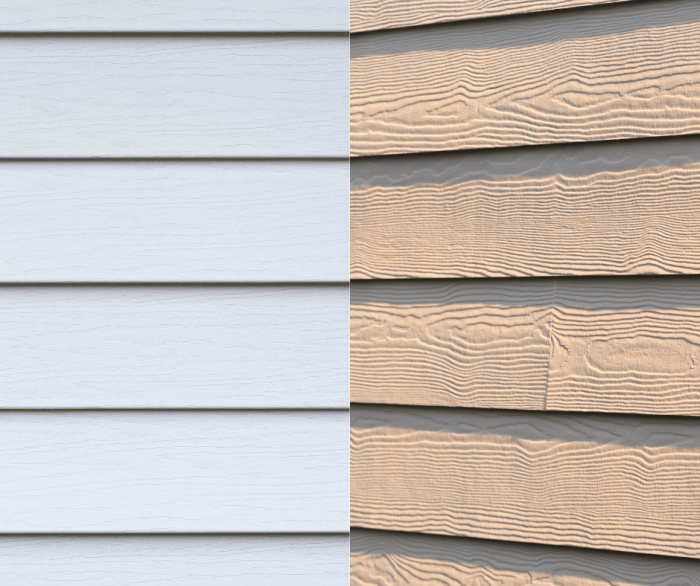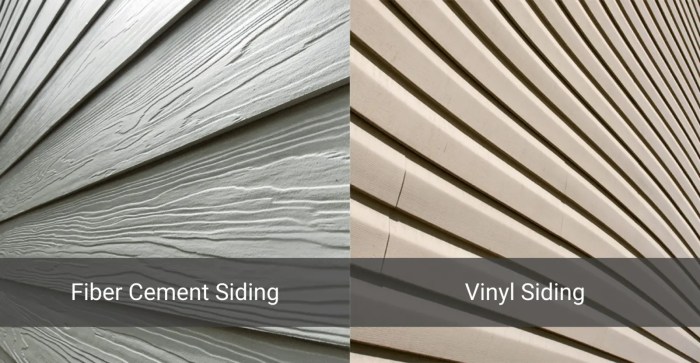When it comes to Vinyl vs fiber cement siding: Pros and cons, get ready for an in-depth comparison that will shed light on the advantages and disadvantages of each. This engaging exploration will help you understand which option might be the best fit for your home.
Overview of Vinyl and Fiber Cement Siding
Vinyl siding is a popular exterior cladding material made from PVC resin. It is known for its low maintenance requirements, affordability, and wide range of colors and styles. Vinyl siding is lightweight, easy to install, and resistant to rot, fading, and insect damage.Fiber cement siding, on the other hand, is a composite material made from a mixture of cement, sand, and cellulose fibers.
It is valued for its durability, fire resistance, and ability to mimic the look of wood siding without the maintenance issues. Fiber cement siding is heavier than vinyl and requires professional installation due to its weight.
Basic Composition and Construction
- Vinyl siding: Made from PVC resin, available in various colors and styles, lightweight, easy to install, low maintenance, resistant to rot and insects.
- Fiber cement siding: Composite material of cement, sand, and cellulose fibers, durable, fire-resistant, can resemble wood siding, heavier than vinyl, requires professional installation.
Durability and Longevity
Vinyl siding is known for its durability in various weather conditions. It is impact-resistant, meaning it can withstand hail and other debris without denting or chipping. Additionally, vinyl siding is moisture-resistant, which helps prevent issues like rotting, warping, or mold growth.
Vinyl Siding in Various Weather Conditions
- Vinyl siding can withstand extreme heat and cold without fading or cracking.
- It is also resistant to salt air, making it a good option for coastal areas.
- Overall, vinyl siding is low-maintenance and can retain its appearance for many years.
Fiber cement siding, on the other hand, boasts exceptional longevity compared to vinyl. Made from a mixture of cement, sand, and cellulose fibers, fiber cement siding is highly durable and can last for decades with minimal maintenance. It is resistant to fire, insects, and rot, making it a popular choice for homeowners looking for a long-term solution.
Longevity of Fiber Cement Siding
- Fiber cement siding can last up to 50 years or more, outlasting many other siding materials.
- It does not expand or contract with temperature changes, reducing the risk of cracks or gaps over time.
- With proper installation and maintenance, fiber cement siding can maintain its appearance for many years.
In terms of examples, vinyl siding is often seen on homes in areas with moderate climates, where it can withstand seasonal changes without significant wear and tear. Fiber cement siding is commonly used in regions with harsh weather conditions, such as heavy rain, snow, or strong winds, due to its superior durability and longevity.
Maintenance Requirements

When it comes to maintaining siding, both vinyl and fiber cement options have specific upkeep requirements that homeowners need to consider.
Vinyl Siding Maintenance
- Regular cleaning with a mixture of soap and water to remove dirt and grime.
- Inspection for any cracks, chips, or damage that may need repair.
- Periodic painting or power washing to keep the color looking fresh.
- Avoiding direct contact with heat sources to prevent warping or melting.
Fiber Cement Siding Maintenance
- Repainting every 5-10 years to maintain the color and protect against moisture.
- Regular inspection for cracks, chips, or signs of damage to address promptly.
- Cleaning with a mild detergent and soft brush to remove dirt and debris.
- Avoiding high-pressure washing to prevent damage to the surface.
Comparison of Maintenance
- Vinyl siding requires less maintenance overall compared to fiber cement, as it does not need painting.
- Fiber cement siding offers better durability but needs more frequent repainting to maintain its appearance.
- Both materials require regular cleaning and inspection to ensure longevity and performance.
Aesthetics and Design Options
When it comes to choosing siding for your home, aesthetics play a crucial role in enhancing the overall look and curb appeal. Both vinyl and fiber cement siding offer unique design options to suit different styles and preferences.
Vinyl Siding Aesthetic Appeal
Vinyl siding is known for its versatility in design and color options. It comes in a wide range of colors, textures, and styles, allowing homeowners to customize their exterior look. Whether you prefer a traditional clapboard style or a modern smooth finish, vinyl siding can easily achieve the desired aesthetic for your home.
Fiber Cement Siding Design Options
On the other hand, fiber cement siding offers a more upscale and sophisticated look. With its ability to mimic the appearance of wood, stucco, or stone, fiber cement siding provides a high-end finish to any home. Homeowners can choose from various textures and styles, including shingles, vertical panels, and architectural designs, to create a unique and visually appealing exterior.
Enhancing Curb Appeal
Both vinyl and fiber cement siding can significantly enhance the curb appeal of a home. Vinyl siding's versatility and affordability make it a popular choice for many homeowners looking to improve their home's exterior appearance. On the other hand, fiber cement siding's durability and upscale look can add value and sophistication to a property, making it a preferred option for those seeking a more premium finish.
Environmental Impact
Vinyl and fiber cement siding both have different environmental impacts based on their production processes and materials used.
Vinyl Siding
Vinyl siding is not considered environmentally friendly due to the harmful chemicals released during its production and disposal. The manufacturing of vinyl releases toxic substances like dioxin into the environment, which can have long-lasting negative effects on ecosystems. Additionally, vinyl siding is not biodegradable and can contribute to landfill waste.
Fiber Cement Siding
Fiber cement siding is generally considered more eco-friendly compared to vinyl siding. The main ingredients used in fiber cement, such as cement, sand, and cellulose fibers, are naturally occurring and less harmful to the environment. Fiber cement siding is also durable and long-lasting, reducing the need for frequent replacements and minimizing waste.
Comparison
In terms of environmental impact, fiber cement siding is a more sustainable option than vinyl siding. While both materials have their own drawbacks, fiber cement's use of natural ingredients and longer lifespan make it a better choice for those looking to minimize their environmental footprint.
Cost Considerations
When it comes to choosing between vinyl and fiber cement siding, cost is a significant factor to consider. Let's break down the initial and long-term expenses associated with each option.
Initial Cost of Installing Vinyl Siding
- On average, the cost of installing vinyl siding ranges from $3 to $7 per square foot.
- This cost includes materials, labor, and any additional supplies needed for installation.
- Overall, vinyl siding is considered more budget-friendly compared to other siding options.
Upfront Expenses for Fiber Cement Siding
- The initial cost of installing fiber cement siding is higher than vinyl, ranging from $6 to $12 per square foot.
- This higher cost is due to the premium quality of fiber cement materials and the labor-intensive installation process.
- Despite the higher upfront expenses, fiber cement siding is known for its durability and longevity.
Long-Term Cost Comparison
- While vinyl siding may have lower initial costs, it may require more frequent maintenance and repairs over time.
- On the other hand, fiber cement siding is known for its longevity and durability, potentially reducing long-term maintenance costs.
- Considering the long-term durability of fiber cement siding, it may be a more cost-effective option in the long run, despite the higher initial investment.
Conclusion
In conclusion, the debate between Vinyl vs fiber cement siding: Pros and cons offers a nuanced look at the various aspects to consider when choosing the right siding for your home. By weighing the pros and cons carefully, you can make an informed decision that enhances both the aesthetics and durability of your property.
FAQ Guide
Is vinyl siding more durable than fiber cement siding?
Vinyl siding is known for its durability in various weather conditions, but fiber cement siding generally has a longer lifespan.
What are the maintenance requirements for fiber cement siding?
Fiber cement siding requires regular painting and caulking to maintain its appearance and protect it from the elements.
Which siding option is more eco-friendly?
Fiber cement siding is considered more eco-friendly than vinyl siding due to its composition and sustainability.
How do the costs of vinyl and fiber cement siding compare in the long run?
While vinyl siding may have lower initial costs, fiber cement siding is often more cost-effective in the long term due to its longevity and durability.



